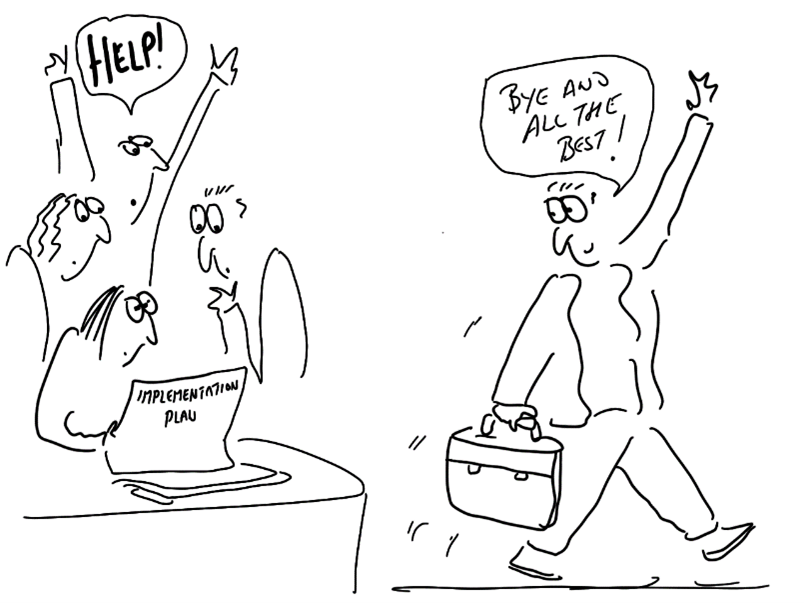
By Ayele Ashagre (with Rick James)
Ending any relationship is never easy. But how funders leave can make such a lasting difference. It says so much about who funders really are, not simply who they aspire to be.
I’ve just evaluated an unusual ‘capacity building for exit’ programme in Ethiopia. This programme funded by Oak Foundation and implemented by Ethiopian consultants supported by INTRAC, showed me that funders can exit responsibly. With appropriate capacity strengthening support, partners can be left stronger and more resilient. Funders can end well.
For the last 15 years, Oak supported Ethiopian partners within their Prevent Child Sexual Abuse Programme. As Oak re-focused its future funding on support for ‘children on the move’, they decided to exit from their six remaining grantees. Towards the end of this process, they considered how to offer the partners capacity strengthening support to ensure that the exit was a responsible one. They asked INTRAC to design a capacity strengthening process that had the potential to leave partners more resilient and able to survive post-exit. INTRAC is committed to shifting the power and localising capacity support, so their first response was to connect with two Ethiopian consultants they had worked well with before. Together they spent a week visiting the six Oak grantees; listening to their strengths, challenges and priority areas for change. They co-created a 20-month programme (Feb 2020 – Oct 2021) to focus on the four grantees with most potential to benefit.
Though the evaluation I was particularly struck by how the programme:
- was locally led: Ethiopian consultants and coaches delivered all the inputs and an Ethiopian social enterprise (Agar Associates) managed it (though INTRAC still had to hold overall accountability for the grant). This largely localised approach made it possible to adjust rapidly in the face of the COVID crisis.
- relied on two accompaniers to support the NGOs throughout the process. The two accompaniers helped cultivate partner ownership; advised NGOs on possible blind-spots and sources of support; briefed consultants on expected approaches; ensured coherence and communication between the different strands; and monitored progress and learning.
- focused on four priority issues: leadership, strategy, resource mobilisation and financial management. Two trained Ethiopian Executive Coaches worked with NGO leaders, using 360° appraisals as a starting point. A consultant also helped the four NGOs to carry out a strategy review, by reflecting on their past activities to discover what has really brought change and why, listening to service users where possible. This helped the NGOs clarify their strategic priorities. Specialist financial consultants undertook a mapping survey of donors in Ethiopia, and then facilitated in-house workshops to explore options for sustainable financing and resource mobilisation. These same consultants also undertook financial capacity assessments, and delivered a series of Humentum-approved financial management trainings. In addition, they helped two NGOs convert their accounting systems to the International Public Service Accounting System (IPSAS) in order to comply with government legislation.
- involved complementary research into leadership transition in Ethiopia. This identified the factors that helped and hindered transition and made practical suggestions for leaders, boards and funders. The research process and feedback has already encouraged Oak partners and other NGOs/CSOs to think more deeply about succession planning and take appropriate actions.

So what difference did all this make?
The programme took place during COVID and related restricted and lockdowns. This caused a few delays. It also meant that many activities had to be done virtually, which as one respondent said, adversely affected the “quality of the communication I had with my leadership coach”. Overall, however, many respondents concluded that:
“The exit capacity development support came at the right time for us. We are equipped and encouraged… We are now working to be self-dependent in the coming 2-3 years.”
Leaders say that have become more self-aware and practice more shared leadership. Some have even started succession planning. The NGOs feel they are clearer about their directions and have updated or created new strategic plans. Their financial systems now meet the requirements of different stakeholders, including the government. Some have developed their own financial sustainability plans and diversified funding sources. Between them in the last two years, they have already accessed new funding from donors such as Ethiopia Aid, Child Help-line, Plan International, Save the Children and the British Council.
This shows that capacity strengthening as part of exit can be done well. It does need funders with foresight. I believe that other international organisations can learn from Oak’s experience. As one NGO leader said to me:
“Some of the funding partners do not care about long-term organisational development. On the contrary to this, Oak came back to us after the programme was completed and provided us with this unique support – this is really excellent”.
To sustain the impact of their development work and leave legacy of resilient grantees, funders’ approach to partnership should include guidelines for responsible exit.
There is so much we can all learn about how to exit well. Look out for forthcoming blogs which will go into more depth about:
– the specific learning about capacity strengthening for exit
– the opportunities and challenges in shifting the power and localising capacity strengthening.
Catch up with the findings from the leadership research part of this programme, with the earlier blog: ‘Please start supporting succession: four practical suggestions from Ethiopian civil society’